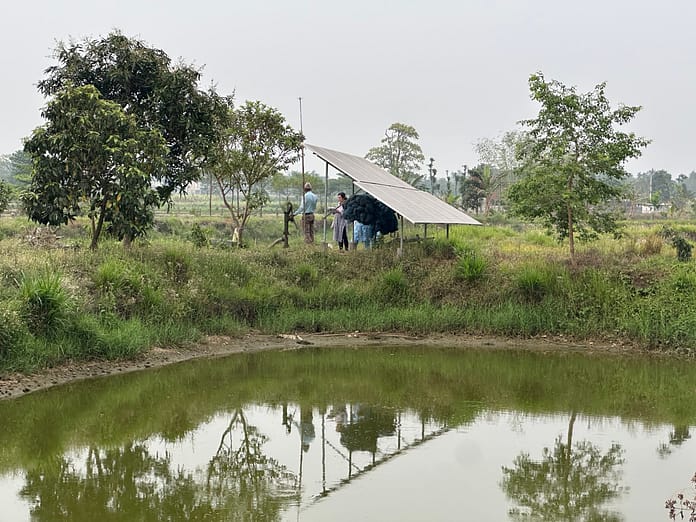A recent study conducted by the International Water Management Institute (IWMI) estimated the economic value of irrigation water for major crops in various agricultural systems of the Nile Basin. It provides important baseline data in a time when water supply is uncertain as a result of climate change.
“This study provided benchmarking data that will help to improve water allocations and encourage conservation,” said Fitsum Hagos, an economist and social scientist with IWMI and lead researcher on the study. “We need accurate estimates of the economic value of water so we can allocate scarce water rationally.”
The demand for water for irrigation is steadily growing in the Nile Basin due to the expansion of irrigation systems and inefficient water use. Agriculture is the single-largest water consumer in the Nile Basin. Total withdrawals for irrigated agriculture amount to roughly 78% of the peak flow of the Nile River at Aswan.
While water demand rises, supply is becoming uncertain due to changes in climate which are influencing precipitation, temperature, and surface water flow. Nile Basin countries must now meet the challenge of overcoming this mismatch between demand and supply by devising new technological solutions, augmenting supply, ramping up conservation efforts, and improving irrigation scheme management.
However, technological solutions alone will not go far enough to remedy to inefficient water use. Hybrid management structures, such as involving farmers in scheme management and incentive structures which reward farmers who implement water conservation measures, should also be considered.
The data from the recent IWMI study can be used to encourage users facing water shortages to improve management or invest in capital that yields more efficient irrigation systems. “Irrigation water pricing is a steppingstone in the path towards developing water systems that enhance conservation,” said Hagos. “The data helps us to develop strategies involving changes in the crop mix or crop rotation that lead to the maximum value per unit of water.”
The study compared four agricultural systems: The intensive system of Egypt, the semi-intensive system of Sudan, the extensive highland of Ethiopia, and extensive lowland of the equatorial lakes region. The study also broadly categorized crops into staples (cereals, including rice), perennial crops (banana and apple), vegetables, root crops (potato, cassava, groundnut, and sweet potato), and industrial crops (cotton and sugar cane).
Researchers’ analysis utilized data from the International Model for Policy Analysis of Agricultural Commodities and Trade (IMPACT), which was developed by the International Food Policy Research Institute in the early 1990s. Crop data and farm-gate prices were sourced from FAOSTAT while global prices were obtained from the World Bank. The data collected include crop yield, amount of irrigation water used, and other inputs used to produce each crop.
The results from analysing farm-gate prices show that perennial crops have the highest value of water, while the value of irrigation water for vegetables was the second highest, followed by root crops and industrial crops. The lowest value was recorded for staple crops. The values based on global prices were generally higher, but the rankings according to crops remained the same. Results from the study are comparable to earlier research, though the current estimates are on the higher side, especially for certain crops.
Meanwhile, the value of irrigation water across the systems showed wide ranges. “This variation of the irrigation water value of a crop is affected by several on- and off-farm factors, including productive use of water and market prices,” said Amare Haileslassie, a principal researcher at IWMI and co-author of the study.
The global scenarios and the data illuminate some potential pathways for utilizing the data. For example, countries with a low value of water for perennials could consider exporting bananas to other countries; similarly, countries with a low value of water for vegetables could export to the other countries.
“The quality and availability of data were major hurdles doing this study,” said Haileslassie. “Future research will need to focus on primary data generation.” To do that, Haileslassie says that countries will be encouraged to start communicating about the need for water valuation while improved data sharing arrangements between riparian countries.
***
This study forms part of the Support to transboundary water cooperation in the Nile Basin project, which is being implemented by IWMI and the Nile Basin Initiative and is supported by GIZ, on behalf of the European Union and German Federal Government. The study’s contents are the sole responsibility of the implementing organizations and do not necessarily reflect the views of the European Union, the German Federal Government, or the Nile riparian countries.
Donor: This project is funded by the German Federal Ministry for Economic Cooperation and Development (BMZ) commissioned by the Deutsche Gesellschaft für Internationale Zusammenarbeit (GIZ) through the Fund International Agricultural Research (FIA). Additional support was provided from the CGIAR Research Program on Water Land and Ecosystems (WLE).
Contact: Dr. Michael Kizza, E: mkizza@nilebasin.org Dr. Fitsum Hagos: E: f.hagos@cgiar.org; Dr. Amare Haileslassie, E: a.haileslassie@cgiar.org.

















